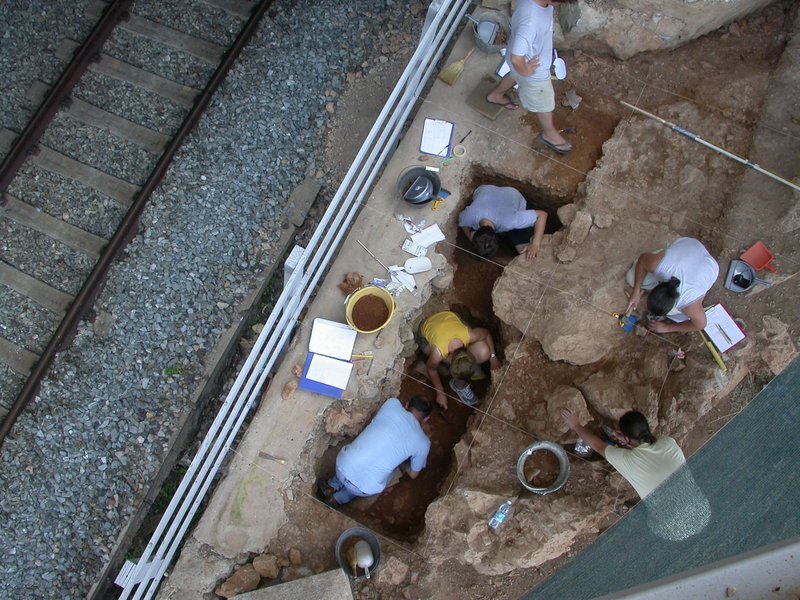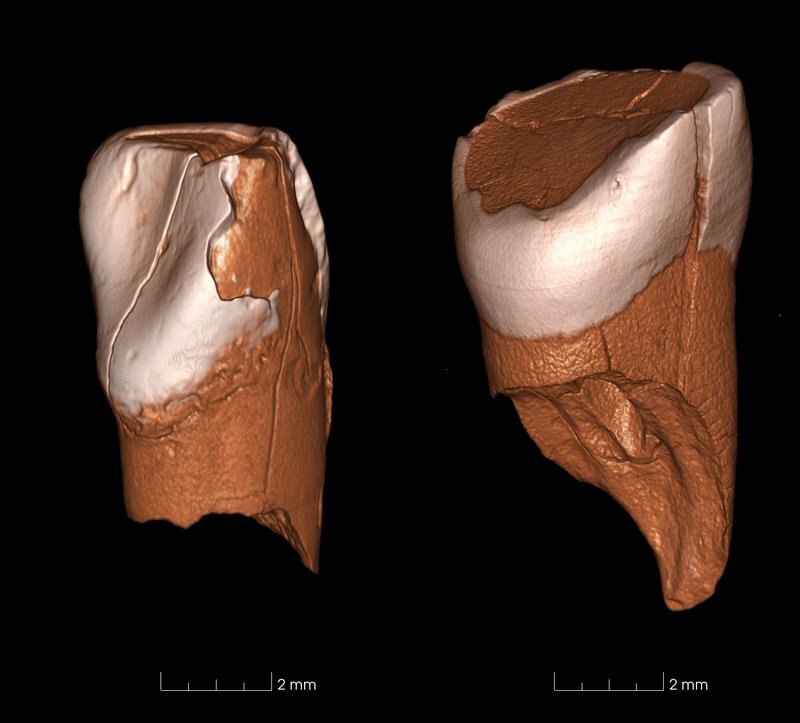
Dental remains from two different sites in Italy suggest that modern humans were responsible for the Protoaurignacian culture, artifacts of which are associated with the arrival of Homo sapiens, or modern humans, in Western Europe.
Stefano Benazzi and colleagues came to this conclusion after studying two 41,000-year-old incisors recovered at excavations at the Riparo Bombrini rock shelter and Grotta di Fumane sites, comparing them to the fossil record and analyzing the remaining enamel on them. One of the teeth contained mitochondrial DNA, which was compared to that of present-day humans, ancient modern humans, Neandertals, Denisovans, a hominin from Spain, and a chimpanzee. The researchers confirmed that the Protoaurignacian incisors belonged to modern humans, making them the oldest human remains associated with Aurignacian culture. And since Neandertals had disappeared from Western Europe by about 39,260 years ago, Benazzi and his colleagues suggest that the Protoaurignacian may have triggered their decline.
_______________________________________
 Riparo Bombrini rock shelter during the 2005 excavation. Scientists have found evidence of Neanderthal occupation at the site, with artifact distribution indicating that Neanderthals had organized and used their spaces in ways similar to that of modern humans. The site was also occupied by later, modern humans. Courtesy Fabio Negrino, Dipartimento di Antichità, Filosofia, Storia e Geografia, Università di Genova, Genova, Italy
Riparo Bombrini rock shelter during the 2005 excavation. Scientists have found evidence of Neanderthal occupation at the site, with artifact distribution indicating that Neanderthals had organized and used their spaces in ways similar to that of modern humans. The site was also occupied by later, modern humans. Courtesy Fabio Negrino, Dipartimento di Antichità, Filosofia, Storia e Geografia, Università di Genova, Genova, Italy
______________________________________
 The Grotta di Fumane. At this site, scientists have found well-preserved living floors of both Neanderthals and modern humans, evidenced by both Mousterian and Aurignacian artifacts. Courtesy Pierluca Grotto
The Grotta di Fumane. At this site, scientists have found well-preserved living floors of both Neanderthals and modern humans, evidenced by both Mousterian and Aurignacian artifacts. Courtesy Pierluca Grotto
_______________________________________
 Three-dimensional digital models of the lower deciduous incisor from Riparo Bombrini (left) and of the upper deciduous incisor from Grotta di Fumane. Courtesy Daniele Panetta, CNR Institute of Clinical Physiology, Pisa, Italy
Three-dimensional digital models of the lower deciduous incisor from Riparo Bombrini (left) and of the upper deciduous incisor from Grotta di Fumane. Courtesy Daniele Panetta, CNR Institute of Clinical Physiology, Pisa, Italy
______________________________________
The finding helps to settle a long-standing debate about the group responsible for this culture, which appeared in Southwest and Southcentral Europe about 42,000 years ago, and coincided with the demise of Neandertals in the region. Researchers have wondered if the Protoaurignacian culture, known for its bladelets and simple ornaments, was a human or Neandertal industry—and whether it gave rise to the modern human Aurignacian culture in southern France. Since Neandertals had disappeared from Western Europe by about 39,260 years ago, Benazzi and his colleagues suggest that the Protoaurignacian may have triggered their decline.
A Perspective article by Nicholas Conard and Michael Bolus discusses this study in greater detail. The research appears in the 24 April 2015 issue of Science.
Science is published by AAAS, the nonprofit science society.
______________________________________
Source: Adapted and edited from the subject AAAS press release.
______________________________________
 You can read our more in-depth articles about new discoveries and developments in archaeology and anthropology with a premium subscription to Popular Archaeology Magazine. Find out what Popular Archaeology Magazine is all about.
You can read our more in-depth articles about new discoveries and developments in archaeology and anthropology with a premium subscription to Popular Archaeology Magazine. Find out what Popular Archaeology Magazine is all about.
In addition, the latest Popular Archaeology ebook is now available.
______________________________________________
Travel and learn with Far Horizons.
____________________________________________
 Popular Archaeology’s annual Discovery Edition eBook is a selection of the best stories published in Popular Archaeology Magazine in past issues, with an emphasis on some of the most significant, groundbreaking, or fascinating discoveries in the fields of archaeology and paleoanthropology and related fields. At least some of the articles have been updated or revised specifically for the Discovery edition. We can confidently say that there is no other single issue of an archaeology-related magazine, paper print or online, that contains as much major feature article content as this one. The latest issue, volume 2, has just been released. Go to the Discovery edition page for more information.
Popular Archaeology’s annual Discovery Edition eBook is a selection of the best stories published in Popular Archaeology Magazine in past issues, with an emphasis on some of the most significant, groundbreaking, or fascinating discoveries in the fields of archaeology and paleoanthropology and related fields. At least some of the articles have been updated or revised specifically for the Discovery edition. We can confidently say that there is no other single issue of an archaeology-related magazine, paper print or online, that contains as much major feature article content as this one. The latest issue, volume 2, has just been released. Go to the Discovery edition page for more information.
____________________________________________






